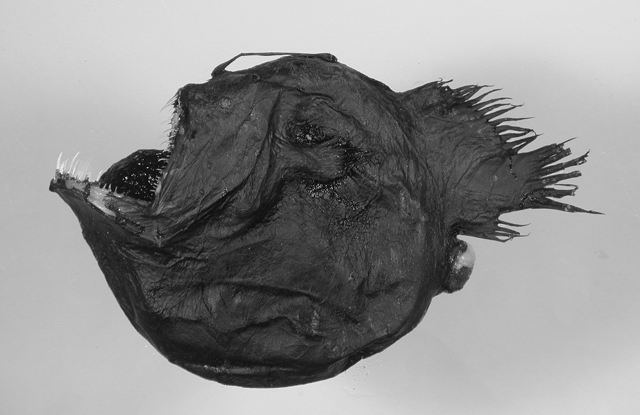| Melanocetidae (Black Seadevils) |
| 2.9 cm TL (male/unsexed); 18 cm TL (female) |
|
bathypelagic; marine; depth range 100 - 4500 m |
| Tropical to temperate parts of all oceans. South China Sea and East China Sea (Ref.74511). |
|
Dorsal spines (total): 1-1; Dorsal soft rays (total): 13-17; Anal spines: 0-0; Anal soft rays: 3-5. Esca with compressed posterior and anterior crests; anterior margin of vomer nearly straight; minute skin spines present over most of body (Ref. 13608). Branchiostegal rays 6 (Ref. 36493). Caudal-fin rays 8. Scales are cone-shaped, hollow and translucent; with circular base and a free edge pointing towards the caudal region. Left otolith, oblong shape with regular edges, inner face does not present rostrum, antirostrum or cisure (Ref. 41244).
Distinguishing characteristics of metamorphosed female: least outside width between frontals 13.5-28.6% SL; upper jaw with 48-134 teeth, lower jaw 32-78 teeth; length of longest tooth in lower jaw 8.4-25% SL; width of pectoral fin lobe 10.7-17.8% SL; width of escal bulb 4.3-8.6% SL; length of illicium 32.4-60.8% SL; skin with minute spinules over most of body; relatively thick integument 1.55 mm (Ref. 86949). Distinguishing characteristics of metamorphosed male: upper denticular with 9-13 ventrally directed anterior teeth and posteromedial series of 8-11 teeth; lower denticular 12-24 teeth; posterior nostril contiguous with eye; at most 24 olfactory lamellae; skin naked or spinulose (Ref. 86949). |
| Meso- and bathypelagic (Ref. 58302). Males dwarfed and non-parasitic (Ref. 4491). Caught with plankton nets (Ref. 559). Capable of catching and swallowing prey larger than itself, as witness the approximately 24.0 cm SL specimen of Chauliodus sp. in the stomach of a 6.6 cm SL individual (NMNZ P 14537) (Ref. 58502). Larvae are found primarily in upper 100 m (Ref. 36493). Oviparous, with planktonic larvae (Ref. 36493). Eggs are presumably contained in floating gelatinous rafts (Ref. 36493). |
|
Least Concern (LC); Date assessed: 09 May 2013 Ref. (130435)
|
| harmless |
Source and more info: www.fishbase.org. For personal, classroom, and other internal use only. Not for publication.
